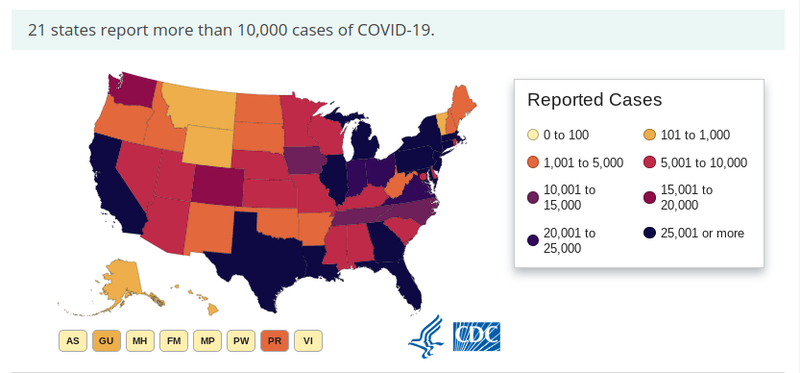Reopening the United States: When is too soon?
May 7, 2020
As local, state, and federal governments face more pressure than ever before to determine the next steps for reopening the United States’ economy and return the workforce to normalcy, citizens have widely differing opinions on what should be next for the country. Exploring undiscovered territory in recent history, health officials and public administrators are attempting to balance a range of factors that are crucial to future American prosperity, and are stepping through a minefield of unknowns in an effort to unify a fractured nation.
Protests are on the rise from those who feel quarantine has gone on long enough; demanding infringement on rights through public protests and signs, many are ready to re-establish financial security. Others are fearful that not enough has been done, or that gains made from efforts to contain COVID-19 for the past several weeks will be lost if interactions are restored too quickly. Many find themselves somewhere in the middle; as stated in the New York Times by the director of the Center for Infectious Disease Research and Policy at the University of Minnesota, Dr. Michael T. Osterholm, “We can’t spend 18 to 24 months in lockdown, but at the same time, this virus is going to keep transmitting, and we have to not let our hospitals get overrun.” The question is, how will we know when to reopen, and how will it be done?
Many health officials believe that the United States as a whole is far from completely reopening the country to allow for standard in-person contact known before the virus’ spread, but the rate of reopening will be based on a state–or even county–level, as urban cities have been hit much harder than rural communities. For this reason, efforts will be made first to slowly open businesses and increase engagement in stages in smaller communities first, and will transition into larger areas as cases decrease.
Various controls must be stabilized prior to continuing reopening efforts, however. First and foremost is increasing the number of tests done in the general population; approximately 1.6% of people in the United States have been tested thus far, according to the COVID Tracking Project.
As the number of tests done and contact tracing abilities increase, so will the number of reported cases in each state; it is crucial that the rate of infections and hospitalizations can continuously be kept at bay, and that PPEs and proper equipment are available for health care workers and essential personnel to utilize, particularly if a second wave of COVID-19 occurs. Until a vaccine or drug can be mass-produced for the public, health administrations nationally also expect states and local legislature to enforce social distancing in workplaces and not allow major reopening measures until daily numbers of cases decline for at least two weeks.
Regardless of warnings from President Trump’s administration, health care professionals, and global leaders dealing with vast outbreaks, some states have prematurely allowed certain public settings to serve customers once more. In late April, states such as Florida, Georgia, and South Carolina were the first to announce taking steps to return to normalcy by opening beaches, restaurants, salons, and other businesses, and have faced immense backlash for doing so.
States with stricter policies, such as Michigan, have paved the way with protests in Lansing, pushing the legislature to advance reopening measures. More have begun to follow since May 1st, but thus far each has shown a rise in reported cases. Protesters and inhabitants of rural cities argue that the economy will only dig a deeper hole if isolation measures continue into the summer months, and that action must be taken to avoid a bigger recession than what is already predicted; as explained by Business Insider, by the year 2030, the debt-to-GDP ratio could hit an all-time high of 150% if places reopen too quickly.
For reference, the ratio post-World War Ⅱ was 121.7%. At the same time, the number of virus-related deaths in the U.S. could surge by at least 300,000 if a proper balance between safety and security are not upheld. As reported to CNBC, “We will face second waves and third waves of this even under the best of circumstances,” stated Jeremy Konyndyk, senior policy fellow at the Center for Global Development. “But if we reopen too early, we’re going to be much worse because the virus now is seeded so much more widely throughout the country, there are a lot more people who can potentially spread it.”
The widespread fear and caution associated with the future cannot be ignored by anyone in today’s society. As of now, Michigan will remain under stay-at-home orders until May 15th while slowly lifting restrictions on travel and limited business openings. Restaurants and essential services will continue to provide for and be supported by community members eager to return to “normal.”
After weeks of restrictions and restlessness, most people are eager to resurface into society–but at what cost? While some believe returning to work, school, and everyday life is long overdue, others recognize the harm that may come from taking too early of action. Without a vaccine or other treatment available, stockpiles of necessary equipment, or certainty about what lies ahead, many are afraid to leave their homes, even if orders are no longer in place, especially those who are most susceptible to COVID-19.
Overall, during this “historic battle against the invisible enemy,” as said by President Trump, it is most important that people focus on the heath of themselves and their loved ones, as we are all facing the consequences of being vulnerable during a time of distress and communal uncertainty.
